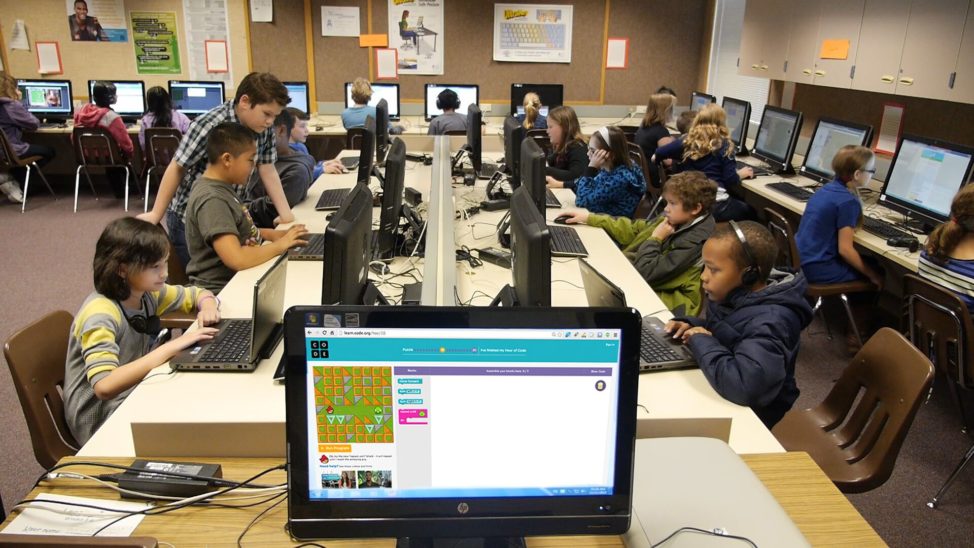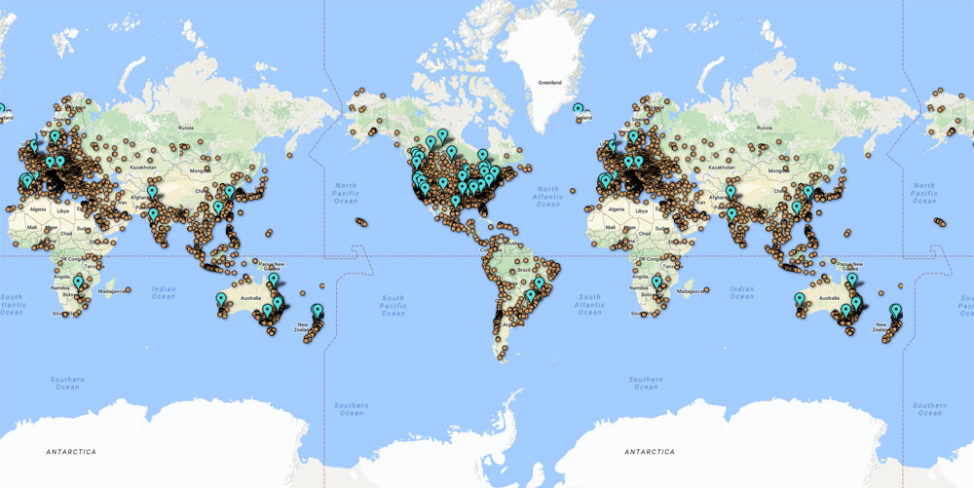
FILE – Fairwood Elementary School students take part in an Hour of Code in Renton, Washington. The picture was taken by our taken by our staff photographer Bow Jones. (Code.org)
You’d think in the age of robotics and artificial intelligence, computer science would be required material for high school students. More often, it is either optional or not offered at all. But nonprofit Code.org is determined to expand access to computer science in schools around the world.
In the U.S., some schools offer computer science, often as an elective. In some parts of the world, computer science isn’t even on the curriculum.
The sad part is that … most students go to a school where even if they want to learn it, their parents want them to learn it, often the teachers won’t be able to teach it – it’s just not offered at that school – Alicia Steinglass, Chief Product Officer at Code.org
Teachers who went to schools 20, 30 or even 10 years ago, “did not learn computer science themselves,” Steinglass told Techtonics. “Most … education schools that prepare teachers to teach computer science … don’t teach computer science.”
Code.org is trying to change all that. The group recently held its fourth annual Hour of Code campaign in December, aimed at introducing teachers and students to computer science. Now, the nonprofit wants to help these teachers bring the subject into the classroom.
“The biggest new time for teachers to teach computer science, to begin to teach it in their classroom, is in January,” said Steinglass. “It’s after they tried computer science and they realized that they can teach it, they can do it, and they begin offering it in their classrooms for their students.”
Hour of Code is a global movement that reaches tens of millions of students in over 180 countries and gives students and teachers the opportunity to try computer science for the first time.

A map that shows some of the regions that participated in Code.org’s December 2016 Hour of Code campaign. (Code.org)
This will be the [very] first time such an event will take place in my country and we plan on inviting our local ministry of education inspectors to be a part of this event – Tassah Academy (Yaounde, Cameroon)
An hour of code will not turn participants into computer science experts, cautioned Steinglass. It will give them a hands-on experience and a feel for the subject, often misjudged and approached with trepidation, particularly among women.
“What we’re trying to do,” she said, “is break stereotypes and help women, help underrepresented minorities, help students who wouldn’t see themselves as computer science students and … teachers who wouldn’t see themselves as computer science teachers try it out so that they can see what it’s about.”
After the December campaign, more than 150,000 teachers registered to have their class learn computer science. “Students loved it,” said Steinglass. “Teachers loved it.”
“And yet,” she continued, “it’s still true that most schools don’t teach computer science despite the fact that nine out of 10 parents want their students to learn it. … When you ask students what subjects [they like] the most, computer science is at the top, just behind art and dance.”
The classes are free, as is the curriculum and all other tools. And while Code.org doesn’t hold workshops in other countries, it provides professional development courses for teachers in the United States to help them teach computer science.
“Internationally, there are other organizations that provide some of that and there are also some online resources that they can use for the teachers to get started,” she said.
Course material, available online, has been translated into several languages, thanks to volunteers and interested groups in various countries.
“We have 20-some languages at this point where the K-5 curriculum has been translated into that language,” said Steinglass. “The Hour of Code has been translated into 50 languages. … And the languages it’s translated into – every single one of these was done by a volunteer partner around the world where somebody cares and wants to bring this to their country and has worked to get it into that.”
Still, computer science is only offered in less than half of the schools in the United States and not at all in some parts of the world. But Steinglass is hopeful.
“This isn’t going to change unless we all work on trying to bring it to schools and [help] make it happen,” she said.

7 responses to “Nonprofit Helps Teachers Bring Computer Science Into the Classroom”
Very interesting and helpful issue! I’m really into it! i am a coordinator teacher responsible for 26 public schools in a region of São Paulo State.
I would really like to learn and contribute to make these issues well kown here and all over the world!
You should contact them or check their website.
Really It is so interesting issues for me since I m an English teacher and I prefer to use tools of technology in my class which enhance learning and attract and motivate students at the same time.
Dear Steinglass, I would like to thank you and your esteemed organization, Code.org. I am very much delighted to know that you are doing such a wonderful job. You are reaching the forgotten. I am called Genene K. Call me just Genene. I live in the regional capital called Hawassa in Ethiopia. I came from very backward pre-urban area where students have no any modern access. Even here in Hawassa we are not able to have good school for our children and with other 99 parents we opened a small school called Yisakor for our children. But yet we are not able to provide computers. We have about 10 PCs which our teachers, from KG to Grade 8 students try to ‘use’ it. So please how can you help us? What do I need to do, for our school and schools back home? Thanks and stay blessed.
This is very interesting. My name is Martha Assefa and I live in Addis Ababa Ethiopia, it would be great if we could get a chance to introduce this program to our schools in Addis and parts of Ethiopia and I would like to get more information on how we could get this opportunity.
Best Regards.
Martha
Thank you for your comment. Please visit the Code.org website for more information about this.
tanx , for scratch programming I trained it .